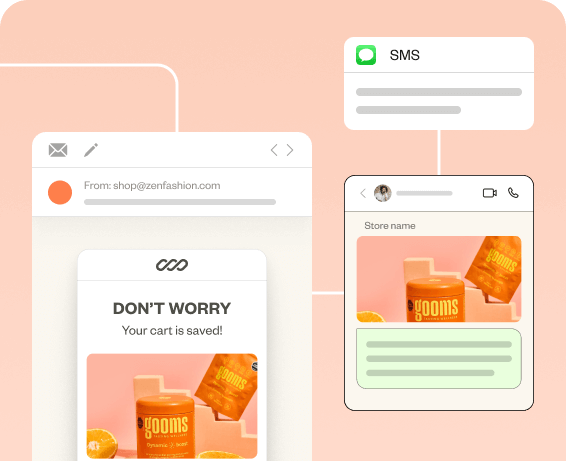Email marketing has been ruling the marketing world with its unmatched ROI and cost-effectiveness.
It holds the key to unlocking business growth and fostering relationships with the target audience.
For businesses looking to build their marketing strategy, email marketing offers a unique blend of reach, relevance, and return on investment that is unmatched by any other digital marketing channel.
So, getting it right means reaping all these benefits.
The challenge of email marketing is its ubiquity – everyone is sending one. So, how do you stand out from those crowded inboxes of your customers?
And how do you make it efficient so that it doesn’t consume much of your resources?
This blog introduces you to the basics of email marketing and provides a step-by-step guide about how to do effective email marketing and tips for creating successful email campaigns.
Do cost-effective email marketing with all the essential features using Retainful.
What is Email Marketing?
Email marketing is a communication channel that involves sending emails to a targeted audience with the aim of promoting products or content and driving customer engagement and sales.
The evolution of email marketing has made it more than just a way to send mass messages. It’s now a sophisticated tool for personalized engagement and building customer relationships.
With the help of modern email automation platforms, you can manage your email campaigns easily and send triggered emails automatically based on specific actions.
What are the Benefits of Email Marketing?
What sets email marketing apart from other channels is its remarkable cost-effectiveness, and add its unique directness that makes each message feel personal and tailored, you have got a channel that beats all others.
Its true strength lies not just in the ability to reach a wide audience but in reaching the right audience in a way that resonates with them. This makes communication with the desired audience engaging and personal.
Here are the reasons why email marketing is the best marketing channel:
Higher ROI
Email marketing is known for its low cost compared to other marketing channels.
As the data says, it gives an ROI of $36 for every $1 spent. This makes it an attractive option for businesses looking to maximize their marketing budget and do affordable email marketing.
Targeted and personalized communication
Email marketing allows for precise segmentation based on their preferences, purchase behavior, and previous interactions with your brand. Then, you can tailor your messages to each of these customer segments.
This makes your marketing emails highly relevant to your customers, leading to higher engagement rates and more email conversion rates.
Automation potential
Digital email marketing can be automated to nurture leads through the sales funnel without manual intervention.
Implementing your email marketing ideas will be way easier when you have email automation by your side. Email marketing automation contains automated workflows that can send welcome emails, follow-ups, and personalized recommendations, saving time while maintaining a personalized approach.
Customer retention
Email marketing is not just effective for acquiring new customers. It’s also an excellent tool for retaining existing ones.
By keeping your audience engaged with valuable content, updates, and offers, you can increase customer loyalty and lifetime value.
Direct communication
Email marketing allows for direct communication with your audience, landing straight into their inbox, which can be more personal and targeted than other forms of digital advertising.
This makes your efforts to build brand awareness much easier, as your brand message will more likely be read by the targeted audience.
Different Types of Email Marketing
Email marketing takes different forms depending on which stage the target customer is in the marketing funnel.
It is imperative to identify the stage and send marketing emails relevant to the customer’s interests and needs, which change at every stage of the email marketing funnel.
In digital email marketing, there are prospects, and there are customers. Each requires a different treatment to prompt them to make the desired action, like making the first purchase or a repeated one.
Here are what types of emails will be suitable for engaging customers at every stage of the funnel.
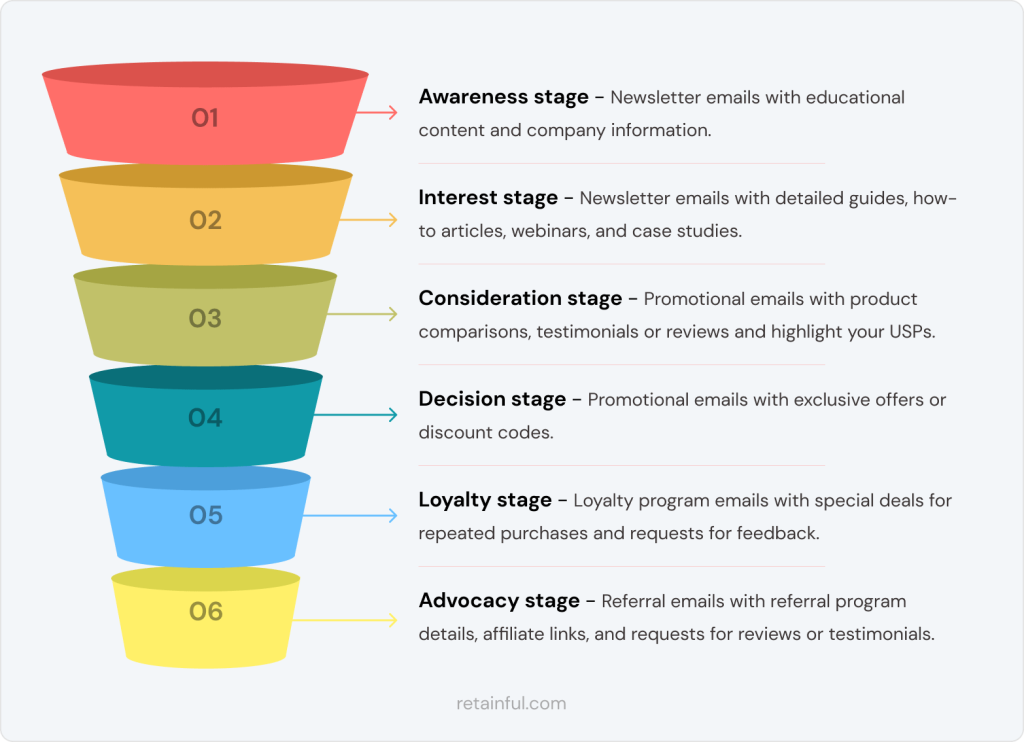
Let’s look at each email marketing example in detail.
1. Newsletter Emails
A newsletter email can include educational content, company updates, and industry news.
The primary aim of newsletters is to engage and inform customers by keeping them well-informed about the latest happenings related to your brand and industry.
Newsletter emails are the most suitable to send to the customers at the top of the email marketing funnel as they focus more on nurturing relationships than driving immediate sales.
Here is an example of a newsletter email template.

2. Welcome Emails
The first direct communication after a prospect subscribes is crucial.
Welcome emails should encapsulate what your brand stands for and what customers can expect. This is your chance to highlight the unique aspects of your brand and how you align with their interests or values.
Here is an example of a welcome email template.
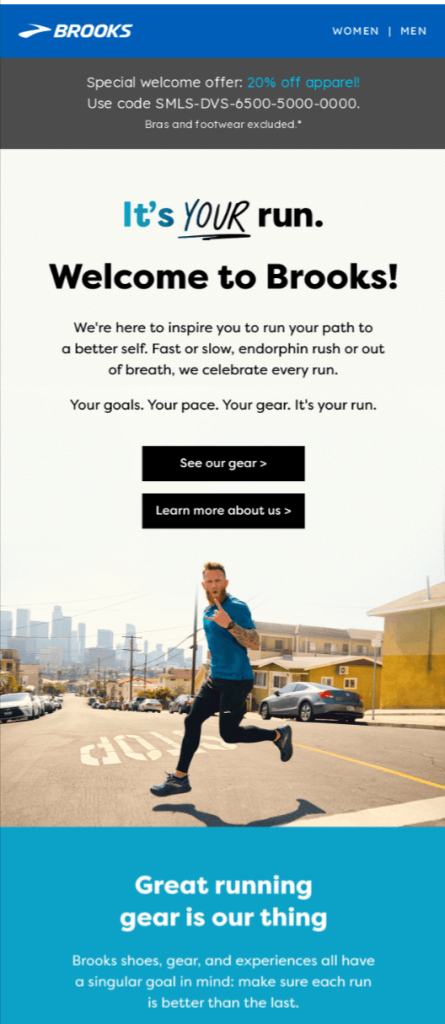
3. Promotional Emails
At the stage where customers are considering buying from you, your goal is to convert consideration into action. Strategic offers and reminders can motivate that final decision.
Time-sensitive discounts or exclusive offers create urgency and can tip the scales in your favor. They should be compelling and clearly communicate the value and benefits of taking action now.
Here is an example of an innovative promotional email.

4. Transactional Emails
In ecommerce email marketing, transactional emails are sent to acknowledge a specific action taken by customers in your store.
Whether it’s an order confirmation, account creation, or request for information, transactional emails offer immediate feedback to customers that their actions have been successful and noted.
By promptly sending transactional emails, you reassure customers that their transactions are being processed as expected. This reliability is fundamental to building and maintaining trust.
Here is an example of an order confirmation email.
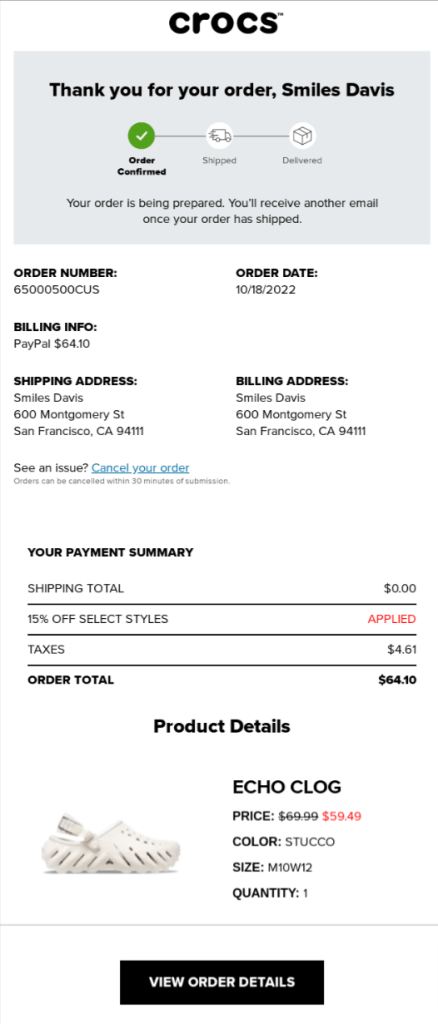
5. Abandoned Cart Emails
If you are doing ecommerce email marketing, more often than not, you would find yourself sending abandoned cart emails because abandoned carts are ubiquitous in ecommerce – that is, 70% of the carts end in abandonment.
Abandoned cart emails have been proven to be successful, as 20% of carts recover through them.
Abandoned cart emails come in handy when you have an ecommerce store and you are doing Shopify email marketing or WooCommmerce email marketing.
Here is an example of an abandoned cart email template.
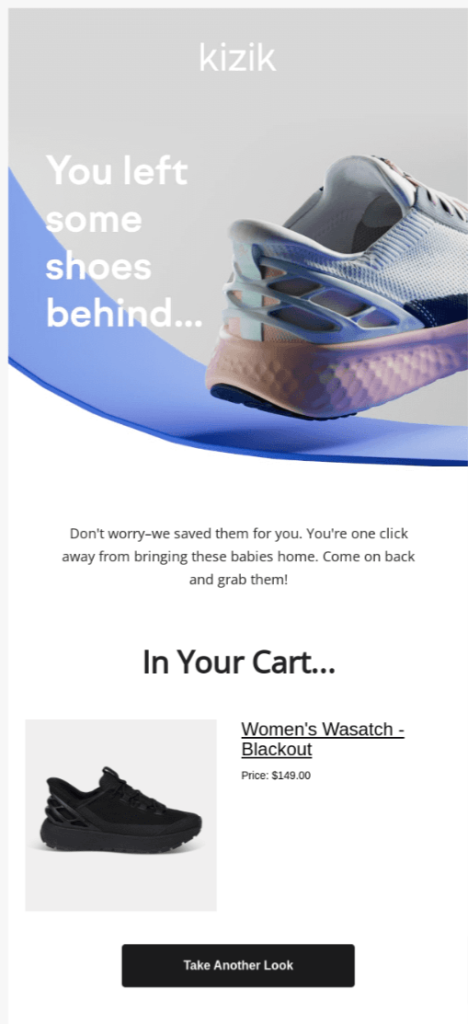
6. Re-engagement Emails
Not every customer sticks with your brand without any break – their interaction with the brand may decrease over time.
Re-engagement email or win-back email aims to re-spark interest and encourage inactive subscribers to engage with your content, products, or services once again.
The content of re-engagement email campaigns should be carefully crafted to appeal to the interests and preferences of the target audience.
You can include:
- Updates on what they have missed while they are away.
- A come-back offer
- Ask a feedback on how you could improve
Here is a win-back email marketing example.
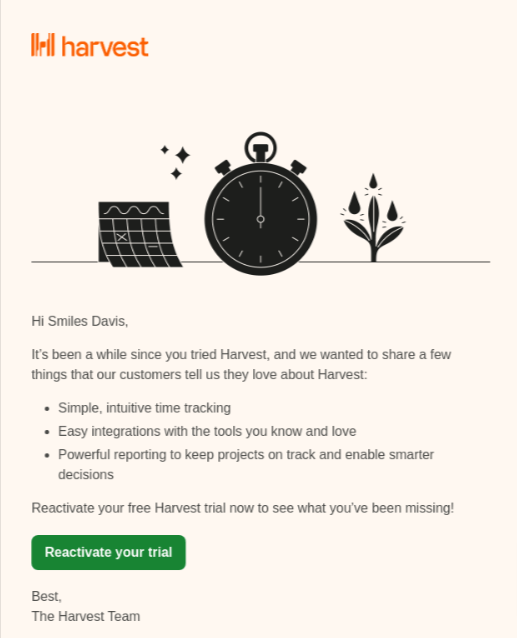
7. Seasonal Emails
Seasonal or holiday emails serve the purpose of aligning your brand with timely events that resonate with your audience.
Whether it’s Christmas, Black Friday, or Valentine’s Day, these emails allow you to connect with customers on a more personal level and tap into their seasonal buying behavior.
Here is a seasonal email template example:
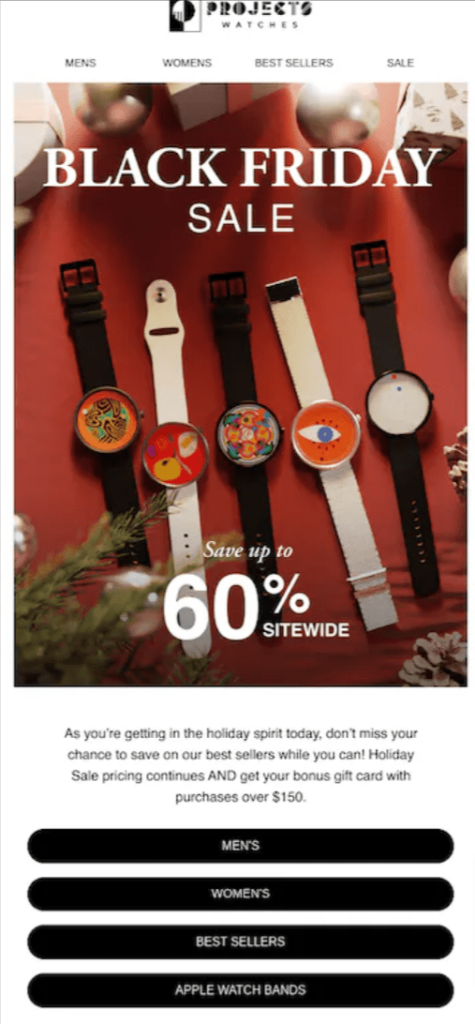
How to do Effective Email Marketing?
Email marketing is more than just sending out emails. It includes understanding your audience, crafting personalizing and relevant content, and utilizing data to optimize your approach.
The steps to do effective email marketing are:
Step 1: Set clear objectives
Step 2: Build an email list
Step 3: Choose an email marketing platform
Step 4: Segment the email list
Step 5: Craft engaging email content
Step 6: Customize email templates
Step 7: Automate email campaigns
Step 8: Test and optimize
Step 1: Set clear objectives
Define what each campaign aims to achieve, whether it’s driving sales, increasing website traffic, or boosting engagement.
So, you know what you have to look for while analyzing your campaign performance and coming up with email marketing ideas.
Here is how to use it to achieve the below objectives:
Sales conversion: If the primary goal is to drive sales and do affordable email marketing, your email campaigns should focus on promoting products or services, highlighting exclusive offers, or showcasing customer testimonials to build trust and encourage purchases.
Website traffic: To increase website traffic, your marketing emails might include compelling content that requires visiting your website to complete the experience, such as detailed blog posts, interactive tools, or exclusive content only available through your site.
Engagement: Boosting engagement may involve creating interactive emails that encourage recipients to reply, participate in surveys, or engage with your brand on social media.
Step 2: Build an email list
The foundation for successful email marketing starts with building an email list.
Building an email list for marketing involves strategically gathering contacts who are interested in your brand, products, or services using popups and signup forms.
You can do this by providing compelling reasons to subscribe to your email list – like offering valuable content, such as blog posts, guides, or ebooks, or an exclusive incentive.
Step 3: Choose an email marketing platform
The best way to do email marketing is to choose an email marketing platform to streamline your marketing efforts and carry out your marketing at scale.
Over the years, an email marketing platform has evolved to do more than just send emails. It can automate your campaigns, segment your customers, customize your emails, and eventually do affordable email marketing.
It completely eliminates the need to manually send emails to every customer and implement your ideas from scratch.
Choosing software requires careful consideration of several key factors to ensure it aligns with your business needs and goals.
Here are some factors to consider:
- Ease of use
- Ecommerce store integration
- Growth adaptability
- Email deliverability
- Pricing structure
Step 4: Segment the email list
Digital email marketing has moved past the mass email blasts stage where every customer receives the same message that lacks relevancy. Targeted email marketing has taken the reins now.
Now, businesses send personalized and targeted emails that resonate with each customer.
What makes this possible is email segmentation.
Email segmentation is where you divide your customers into smaller, more specific groups, and send targeted emails that are more likely to resonate with each segment’s unique interests and needs.
Here are some segmentation criteria you can consider to segment your email list for marketing:
- Based on behaviour: Segment your list based on user actions, such as purchase history or content engagement, to tailor your messaging.
- Demographic segmentation: Use information like age, location, or job title to create segments that allow for personalized communication.
- Engagement level: Differentiate between active subscribers and those who haven’t engaged recently to tailor your re-engagement efforts.
Step 5: Craft engaging email content
The more engaging the email content is, the more it motivates the customer to carry out the desired action, leading to more conversions.
Here are three basic things you should nail in your creative email marketing.
- Know your audience: Write content that addresses the interests, needs, and pain points of your audience segments.
- Use compelling subject lines: Your subject line should grab attention and give a compelling reason to open the email.
- Include clear CTAs: Every email should have a clear call-to-action, guiding subscribers on what to do next.
Step 6: Customize email templates
By customizing your marketing email templates, you reinforce your brand identity in your email.
The best practice is that your email templates across the email campaign should maintain consistency in visual elements and the tone and voice of your content.
Your customized marketing email templates should pass three tests:
- Branding consistency – Does the tone and voice reflect the brand’s personality?
- Mobile optimization – Are you designing responsive email templates and fast loading times?
- Personalized elements – Is your content curated specifically for the customer segment you are targeting?
Step 7: Automate email campaigns
Automating your email campaigns increases the efficiency of your digital email marketing efforts.
Email automation turns traditional, time-consuming marketing into a streamlined one that drives results even when you are not actively managing each email campaign.
By setting up automated sequences tailored to specific customer behaviors, you can ensure that your email campaigns consistently engage the targeted customers at the most opportune times and carry out advanced email marketing.
Step 8: Test and optimize
Testing and optimizing are critical processes that ensure your campaigns are not just executed but are continually evolving to meet the needs and preferences of your audience more effectively.
You can do A/B testing on subject lines, email content, CTAs, and design. Then, use the insights and KPIs (Key performance metrics) gained from A/B testing to refine and improve your email marketing strategy continuously.
Tips for Creating Successful Email Marketing Campaigns
Creating an email marketing campaign involves more than just sending emails. It’s about creating a strategic, engaging, and measurable way to connect with your audience, offering them value, and encouraging them to take desired actions.
Here are the tips for doing successful email marketing:
- Know your audience
- Set clear objectives
- Craft compelling subject lines
- Leverage automation
- Personalize your emails
- Keep your design clean and responsive
- Write concise and compelling copy
- Include a clear Call to Action (CTA)
- Avoid spamming
- Keep experimenting
Let’s see the tips in detail.
Know your audience
Understanding who you’re emailing is the first step.
This involves more than just understanding demographic information. You should gain deep insights into their behaviors, preferences, challenges, and motivations.
Once you have a good understanding of your audience, segmenting them into specific groups allows for more targeted and effective email marketing.
For example, if you want to send a referral email, you can’t send it to a new customer. A customer who has made repeated purchases would be more inclined to refer your brand to their friends.
So, you have to segment your audience into new and repeated ones and send the referral email to the latter.
Craft compelling subject lines
Your email subject lines determine whether an email is opened. So, creative email marketing should make it intriguing and clear, providing a hint of what’s inside.
The effectiveness of your subject line directly impacts your email’s open rates, a critical metric in email marketing.
Leverage Email Automation
The best way to do email marketing is to use automated emails for welcome series, abandoned cart reminders, and follow-up emails to keep your brand on top of your mind without constant manual effort.
Email marketing automation can save a considerable amount of time and resources.
Instead of manually creating and sending emails to different segments of your audience, automation allows you to set up triggers and workflows once and let the system manage the execution.
The marketing emails are triggered automatically after specific customer action or inaction – when customers abandon the cart, make the first purchase, or haven’t purchased in a while.
Personalize your emails
A best practice for email marketing is to go beyond just mentioning the recipient’s name while sending targeted email campaigns You should create an experience that feels uniquely tailored to each subscriber.
Personalized emails tend to have a higher open rate and conversion rate as these emails are more effective in guiding the customers to take the desired action, whether it’s making a purchase, signing up for an event, or engaging with content.
The foundation of personalization is a deep understanding of your audience.
If you are doing ecommerce email marketing, this involves analyzing data on customers’ behaviors, preferences, and interactions with your brand – like purchase history, email engagement data, and demographics.
Keep your design clean and responsive
A clean email marketing template design ensures that your message is easily digestible, while a responsive layout guarantees that your email looks great on any screen size, from desktop monitors to smartphones.
In this time of short attention spans, a clutter-free design helps recipients quickly grasp your message without being overwhelmed by too much text or too many images.
Write concise and compelling copy
The email marketing best practice is to craft email content that combines clarity, persuasion, and relevance to engage the reader and encourage action.
Most people skim through emails to decide if something is worth reading in detail. So, creative email marketing with short, to-the-point copy is more likely to be read while the readers are skimming. To streamline this process, Editpad’s Email Writer is recommended as it can help you create attention-grabbing emails with ease. By using it, you can ensure that your message resonates even during a quick skim.
Include a clear Call to Action (CTA)
Make it obvious what you want the reader to do next, whether it’s visiting a webpage, making a purchase, or signing up for an event.
Ensure that your CTA is prominently displayed and easily accessible within your marketing emails.
Use persuasive language that motivates recipients to act. Words like “Shop Now,” “Subscribe Today,” or “Get Started” convey a sense of urgency and encourage immediate action.
Master the timing
Identifying the best time to send email campaigns is crucial for maximizing open rates, engagement, and conversions.
The optimal timing can vary significantly depending on your audience, industry, and the nature of your email content.
The word has it that the best time to send marketing emails is during the middle of the week, specifically on Tuesdays, Wednesdays, and Thursdays.
Avoid spamming
To avoid spamming, it’s crucial to adhere to best practices that respect both legal requirements and your recipients’ preferences.
Here are some key tips to do that.
- Obtain consent – Always obtain explicit consent through double opt-in from recipients before adding them to your mailing list. This is called permission email marketing.
- Provide an unsubscribe option – Include an easy-to-find unsubscribe link in every email you send. This not only complies with laws like the CAN-SPAM Act but also respects the recipient’s choice and helps maintain your email list quality.
- Use a reputable ESP – A reputable ESP will help ensure your emails are compliant with email marketing regulations and ensure that you achieve high email deliverability rates.
Keep experimenting
The digital email marketing landscape is always evolving. So, be open to new ideas and techniques to stay relevant.
Instead of sticking to the mold, try out innovative email marketing ideas to craft engaging email content and how to use email marketing to make more conversions.
How to choose the best Email Service Provider (ESP)?
Choosing the best email sevice provider is crucial for the success of your email campaigns. The right ESP can simplify your campaign management and bring in overall efficiency.
An email service provider will streamline your creation, execution, and analysis of email campaigns, which are otherwise time-consuming and tedious.
Here are some factors to consider when choosing the right email service provider:
Email deliverability: The most important feature of an ESP is its ability to deliver emails to your recipients’ inboxes, avoiding spam folders.
Ease of use: The ESP should be user-friendly, allowing you to easily create email automation workflows. It should offer intuitive design tools, templates, and a straightforward dashboard to monitor your campaigns.
Features and functionality: Consider the features you need for your email marketing efforts. This may include automation, segmentation capabilities, A/B testing, personalization options, and advanced analytics to track open rates, click-through rates, and conversions.
Integration: Your ESP should integrate seamlessly with your other marketing tools and systems, such as your CRM, website, and your e-commerce platform.
Explore more email marketing tools and their detailed comparison:
8 Best Email Automation Software Comparison
The 11 Best Email List Building Tools To Increase Conversions
10 Best Klaviyo Alternatives & Competitors for 2025
Get started with Retainful and automate all your email campaigns with a beginner-friendly interface.
Also Read:
- Retention Marketing: Strategies + Examples
- Customer Lifecycle Marketing – Strategies for Each Stage + Examples
- Shopify Email Marketing: A Guide to Create Email Marketing Campaigns
Wrapping up!!
From building lasting relationships with your audience to pushing the needle on your sales, email marketing stands out as a remarkably cost-effective strategy.
It’s like having a direct line to your audience’s inbox, where you can share your story, showcase your products, and invite feedback, all while keeping your brand at the forefront of their minds.
In this blog, we have covered enough ground about the basics of email marketing, why it is the best marketing channel, how to get started with it, and some tips to make it high-converting.
Remember, the key to email marketing isn’t just about sending emails; it’s about building relationships. Start with what you’ve learned here, keep experimenting, and always focus on providing value to your subscribers.
Learn more about email marketing.
- 10+ Email Acquisition Strategies To Grow Email List
- Retention Marketing: Strategies + Examples
- 7 Best Double Opt-in Email Examples + Best Practices
Frequently Asked Questions
Choose an email marketing platform, build your list, segment your audience, design engaging content, test and optimize your emails, analyze results, and refine your strategy based on feedback and metrics.
Email marketing costs vary depending on factors like platform choice, list size, and feature requirements. Costs increase with advanced features and larger subscriber counts.
The most effective email marketing strategy would be personalization, where you segment your audience to send targeted, relevant content which results in higher conversion rates.
The ideal number of marketing emails varies by audience and purpose, but aiming for 1-2 emails per week allows for engagement without overwhelming subscribers, maintaining interest and relevance.
Frequency should be tailored to your audience’s preferences and engagement levels, but generally, sending 1-2 emails per week is effective in keeping your audience engaged without overwhelming them.
Yes, email marketing campaigns are worth it. They offer a high ROI, personalization opportunities, and measurable results, making them a cost-effective tool in a comprehensive digital marketing strategy.
The ideal number of emails in a campaign depends on the campaign’s goal and duration, but typically, 3-5 emails are effective for nurturing leads without overwhelming subscribers or causing email fatigue.
Key performance metrics for email campaigns include open rate, click-through rate (CTR), conversion rate, unsubscribe rate, list growth rate, and email forwarding rate or share rate.
